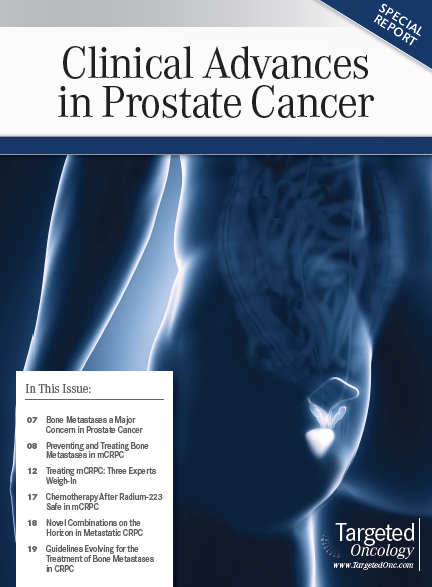Chemotherapy Safe After Radium-223 for Men With mCRPC
The explosion of new drugs for the treatment of castration-resistant prostate cancer (CRPC) is a welcome advance, but raises questions about how best to sequence these drugs with standard docetaxel chemotherapy.
The explosion of new drugs for the treatment of castration-resistant prostate cancer (CRPC) is a welcome advance, but raises questions about how best to sequence these drugs with standard docetaxel chemotherapy. A subanalysis of the ALSYMPCA trial suggests that chemotherapy can be safely administered after treatment with radium-223 (Xofigo), which is the only approved radiopharmaceutical for patients with metastatic CRPC and bone metastasis.
The study, which was presented at the 2015 European Cancer Congress, was a post-hoc analysis of patients enrolled in ALSYMPCA who received chemotherapy post treatment with radium-223 and post treatment with placebo. Follow-up was 3 years.
“This study has some limitations, including the fact that it represents a subset of patients based on postrandomization factors, including study drug treatment with radium-223 or placebo, and randomization of the original study does not ensure comparability of the treatment arms,” said lead author Oliver Sartor, MD, Tulane Cancer Center, New Orleans, LA.
“Given these limitations, this post-hoc analysis indicates that chemotherapy following radium-223 appears to be safe, with no new hematologic concerns and no new detrimental effects on survival. Patients who were earlier in the course of disease and received all 6 injections of radium-223 were able to receive subsequent chemotherapy. This encouraging finding confirms the flexibility and versatility of radium-223, supporting the safety of administering chemotherapy after radium-223 regardless of prior docetaxel use,” Sartor stated.
Of 921 patients enrolled in ALSYMPCA, 206 (22%) received chemotherapy post study: 142 from the radium-223 arm and 64 from the placebo arm. Docetaxel was the most commonly used post-study chemotherapy; 70% of the post-radium-223 arm and 72% of the post-placebo arm were treated with docetaxel. Subgroup analysis was performed according to prior docetaxel use.
Demographic and baseline characteristics were generally well balanced between the treatment arms in the chemotherapy post-study drug subgroups for age, baseline ECOG status, extent of disease, prostatespecific antigen (PSA) levels, and other parameters.
Compared with the original ALSYMPCA population, the chemotherapy post-study subgroup patients were younger, had better ECOG performance status, lower disease volume (number of metastases), and lower total alkaline phosphatase levels and lower PSA levels. Compared with the overall ALSYMPCA population, a greater percentage of patients in the post-study drug subgroup received all 6 planned injections of study drug: for those assigned to radium-223, 63% of the overall ALSYMPCA population and 79% of the chemotherapy post-study subgroup got all 6 injections, and 47% and 58%, respectively, of the placebo group got all 6 planned injections.
In both chemotherapy post-study group arms, median hematologic lab values remained constant from the last measurement before chemotherapy to 18 months after chemotherapy. These hematologic values were similar for patients who received prior docetaxel and no prior docetaxel. No treatment differences in hematologic values were observed within the no-prior and prior docetaxel subgroups.
Decreases from baseline in hemoglobin and neutrophil levels were similar in the two treatment arms. Decreases from baseline in platelets tended to be greater in the radium-223 arm compared with placebo, but this was likely due to radium-223 rather than subsequent chemotherapy, according to Sartor. Decreases in platelets were similar in patients who had prior docetaxel and no prior docetaxel. The rates of grade 3 or 4 hematologic adverse events were generally low, but were somewhat higher in the radium-223 arm compared with the placebo arm.
No significant difference in survival was observed between radium-223 and placebo during or within 30 days of completing chemotherapy. Twenty-nine percent of patients in the radium-223 group and 33% in the placebo group died during and within 30 days of completing chemotherapy. The most common cause of death was prostate cancer (90% in the radium-223 arm and 95% in the placebo arm). Median overall survival (OS) from the start of chemotherapy was 18 months after radium-223 and 15.8 months after placebo, which was not statistically different.
References
- Sartor O, Coleman RE, Nilsson S, et al. 3-year follow-up of chemotherapy following radium-223 dichloride (Ra-223) in castration-resistant prostate cancer (CRPC) patients (Pts) with symptomatic bone metastases (Mets) from ALSYMPCA. Presented at: European Cancer Congress 2015; Poster session; Vienna, Austria. Abstract 2510.
